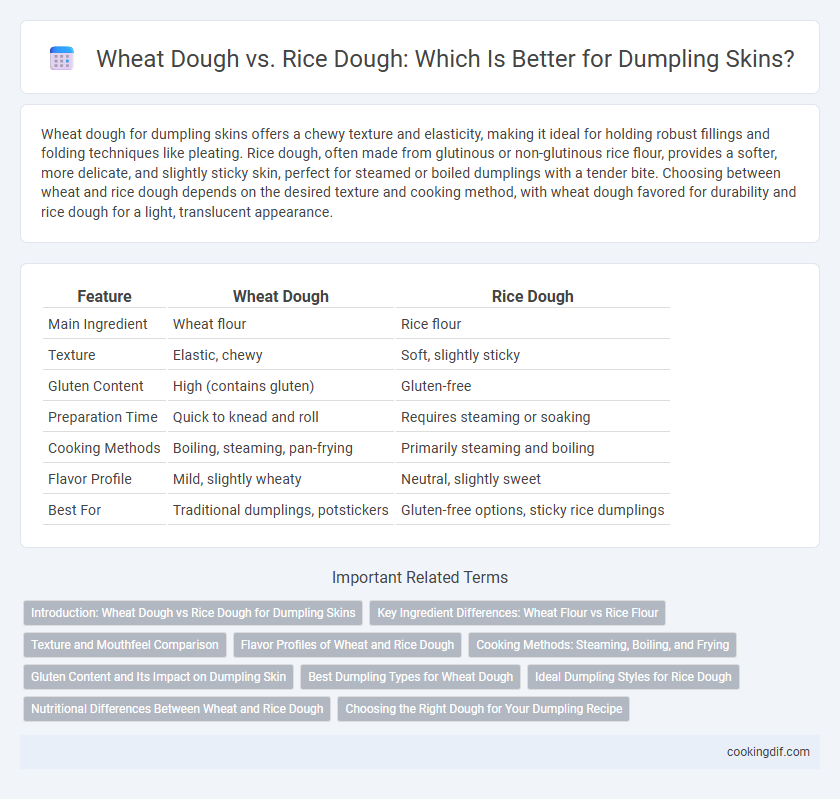Wheat dough for dumpling skins offers a chewy texture and elasticity, making it ideal for holding robust fillings and folding techniques like pleating. Rice dough, often made from glutinous or non-glutinous rice flour, provides a softer, more delicate, and slightly sticky skin, perfect for steamed or boiled dumplings with a tender bite. Choosing between wheat and rice dough depends on the desired texture and cooking method, with wheat dough favored for durability and rice dough for a light, translucent appearance.
Table of Comparison
| Feature | Wheat Dough | Rice Dough |
|---|---|---|
| Main Ingredient | Wheat flour | Rice flour |
| Texture | Elastic, chewy | Soft, slightly sticky |
| Gluten Content | High (contains gluten) | Gluten-free |
| Preparation Time | Quick to knead and roll | Requires steaming or soaking |
| Cooking Methods | Boiling, steaming, pan-frying | Primarily steaming and boiling |
| Flavor Profile | Mild, slightly wheaty | Neutral, slightly sweet |
| Best For | Traditional dumplings, potstickers | Gluten-free options, sticky rice dumplings |
Introduction: Wheat Dough vs Rice Dough for Dumpling Skins
Wheat dough for dumpling skins offers elasticity and chewiness due to its gluten content, making it ideal for traditional steamed or boiled dumplings. Rice dough, made from rice flour, provides a naturally gluten-free alternative with a softer, more delicate texture suitable for translucent dumplings like cheong fun. Comparing wheat and rice dough highlights differences in texture, taste, and dietary suitability critical for diverse dumpling recipes.
Key Ingredient Differences: Wheat Flour vs Rice Flour
Wheat dough for dumpling skin is primarily made from wheat flour, which contains gluten, providing elasticity and a chewy texture essential for holding fillings securely. Rice dough, made from rice flour, lacks gluten, resulting in a more delicate, slightly sticky texture that is often translucent when cooked. The choice between wheat and rice flour as key ingredients significantly affects the dumpling's texture, flexibility, and suitability for steaming or frying.
Texture and Mouthfeel Comparison
Wheat dough for dumpling skin offers a chewy and elastic texture due to its gluten content, creating a satisfying mouthfeel that holds fillings well. Rice dough, lacking gluten, produces a softer, more delicate skin with a slightly sticky surface, giving dumplings a tender bite and subtle chewiness. The choice between wheat and rice dough significantly influences the dumpling's overall texture, with wheat dough favored for robustness and rice dough preferred for lightness and smoothness.
Flavor Profiles of Wheat and Rice Dough
Wheat dough for dumpling skins offers a chewy texture and a rich, slightly nutty flavor that enhances savory fillings. Rice dough delivers a delicate, mildly sweet taste with a smoother, softer texture, making it ideal for light or seafood-based dumplings. Flavor profiles distinctly influence the overall eating experience, with wheat dough providing heartiness and rice dough contributing subtle sweetness.
Cooking Methods: Steaming, Boiling, and Frying
Wheat dough dumpling skins offer elasticity and firmness, making them ideal for frying and boiling as they retain shape and develop a chewy texture. Rice dough skins, being more delicate and translucent, excel in steaming, producing a soft, tender wrapper that enhances the dumpling's delicate fillings. Cooking methods influence the choice of dough, with wheat dough favoring high-heat frying and boiling, while rice dough suits gentle steaming to preserve integrity and flavor.
Gluten Content and Its Impact on Dumpling Skin
Wheat dough contains a high gluten content, providing elasticity and chewiness that results in dumpling skins with a firm, slightly stretchy texture ideal for boiling or pan-frying. Rice dough lacks gluten, producing more delicate, tender skins that are softer and often preferred in steamed or fried dumplings with a smoother, less elastic bite. The gluten content directly affects the dumpling skin's strength and texture, influencing cooking methods and overall eating experience.
Best Dumpling Types for Wheat Dough
Wheat dough, made from wheat flour and water, is ideal for dumplings like Chinese jiaozi, Japanese gyoza, and Korean mandu due to its elasticity and chewiness. This dough type holds fillings well and creates a soft yet slightly chewy skin that enhances the overall texture and flavor of the dumpling. Rice dough, on the other hand, is more suitable for delicate, translucent dumplings like Vietnamese banh bot loc but lacks the stretch and robustness preferred in wheat dough dumplings.
Ideal Dumpling Styles for Rice Dough
Rice dough, known for its soft and slightly sticky texture, is ideal for delicate dumpling styles such as Cantonese har gow and Cheung fun, where thin, translucent skins enhance the sensory experience. Unlike wheat dough, which offers elasticity and a chewier bite suitable for hearty dumplings like jiaozi or gyoza, rice dough excels in steamed or pan-fried dumplings requiring a smooth, tender wrapper. Its gluten-free nature appeals to dietary preferences while providing a subtle sweetness that complements seafood or vegetable fillings commonly used in rice dough dumplings.
Nutritional Differences Between Wheat and Rice Dough
Wheat dough for dumpling skins contains higher protein and gluten, essential for elasticity and chewiness, while rice dough is gluten-free, making it suitable for gluten-intolerant diets but typically lower in protein. Rice dough often has a higher glycemic index, leading to quicker glucose absorption, whereas wheat dough offers more fiber, aiding digestion and providing sustained energy release. Vitamins and minerals like B vitamins and iron are more abundant in wheat dough, enhancing its nutritional profile compared to the relatively lower micronutrient content in rice dough.
Choosing the Right Dough for Your Dumpling Recipe
Wheat dough offers elasticity and a chewy texture, making it ideal for traditional dumplings like jiaozi and potstickers, while rice dough provides a delicate, translucent wrapper perfect for steamed dumplings such as har gow. Selecting the right dough depends on the desired texture, cooking method, and regional flavor profile of your dumpling recipe. Considering gluten content and moisture levels in the dough helps achieve the optimal balance between pliability and firmness for a perfect dumpling skin.
Wheat dough vs Rice dough for dumpling skin Infographic

 cookingdif.com
cookingdif.com